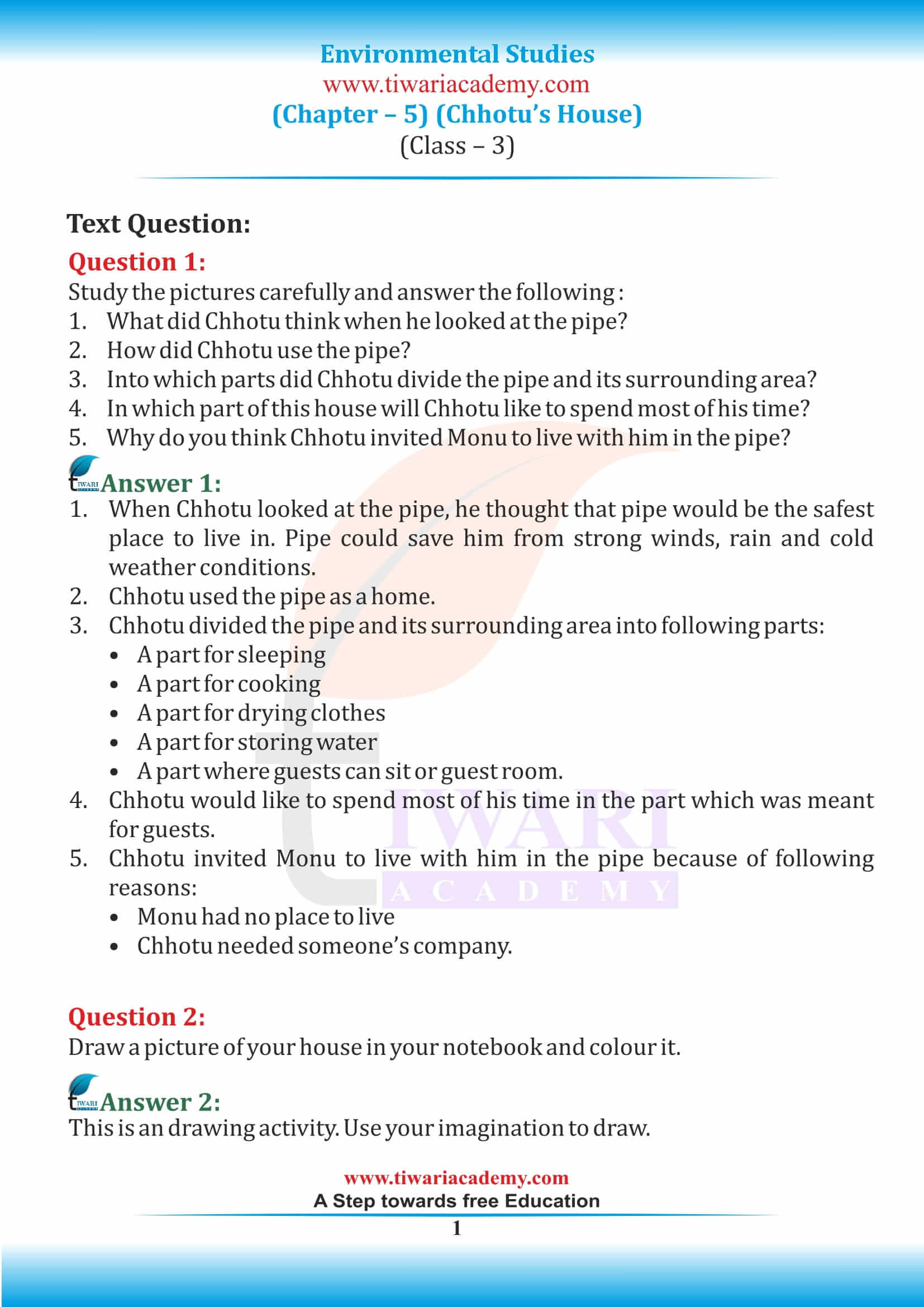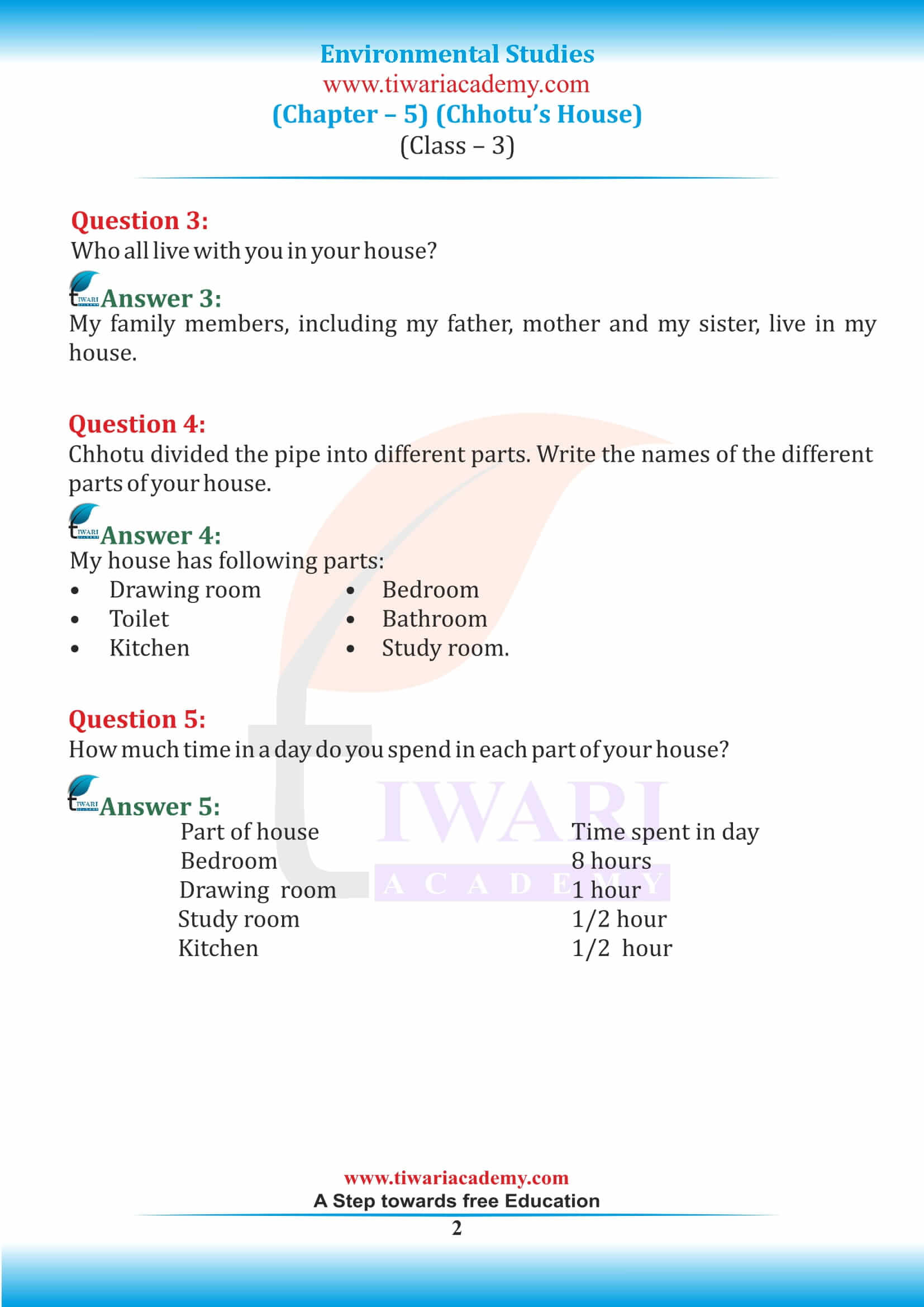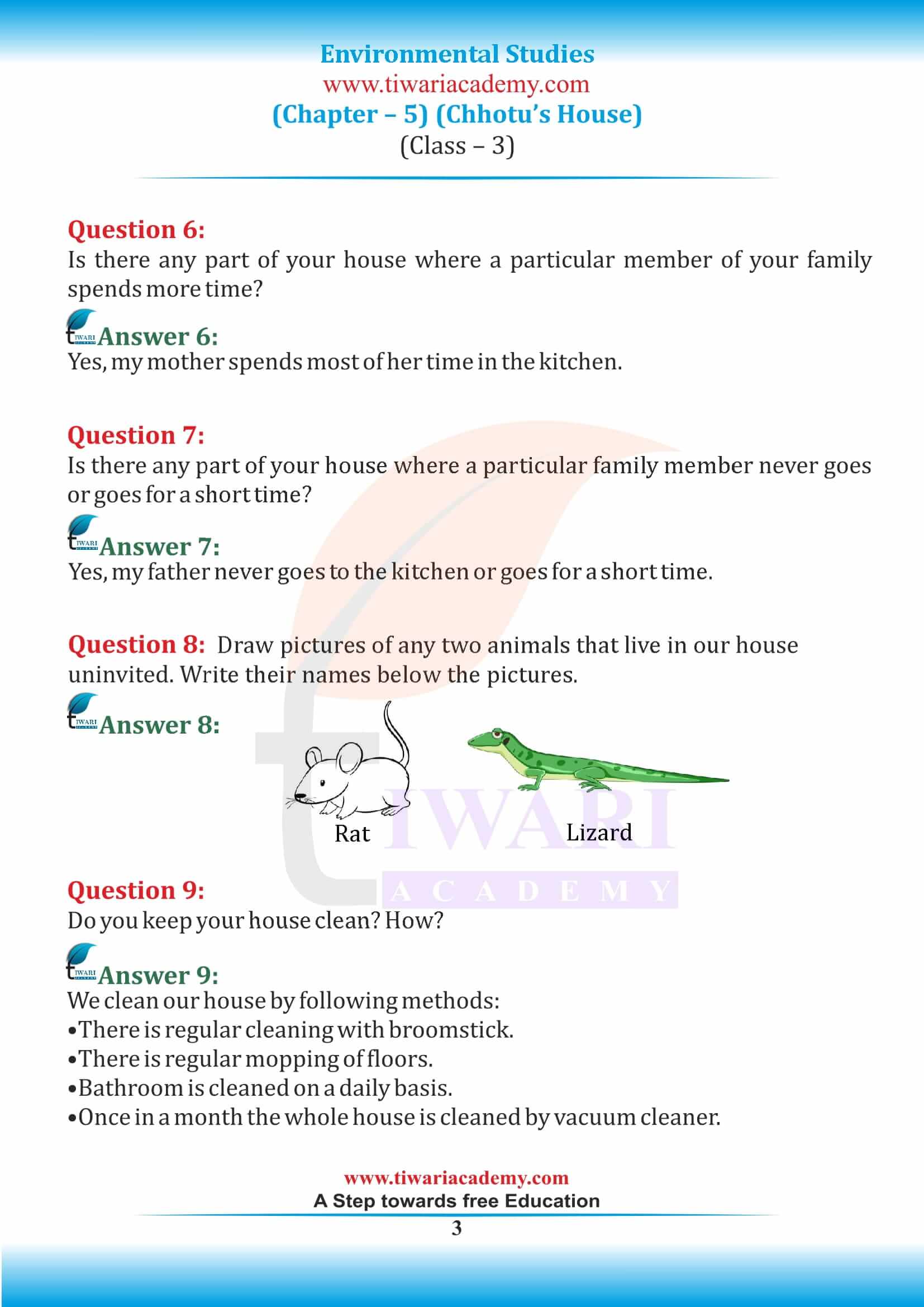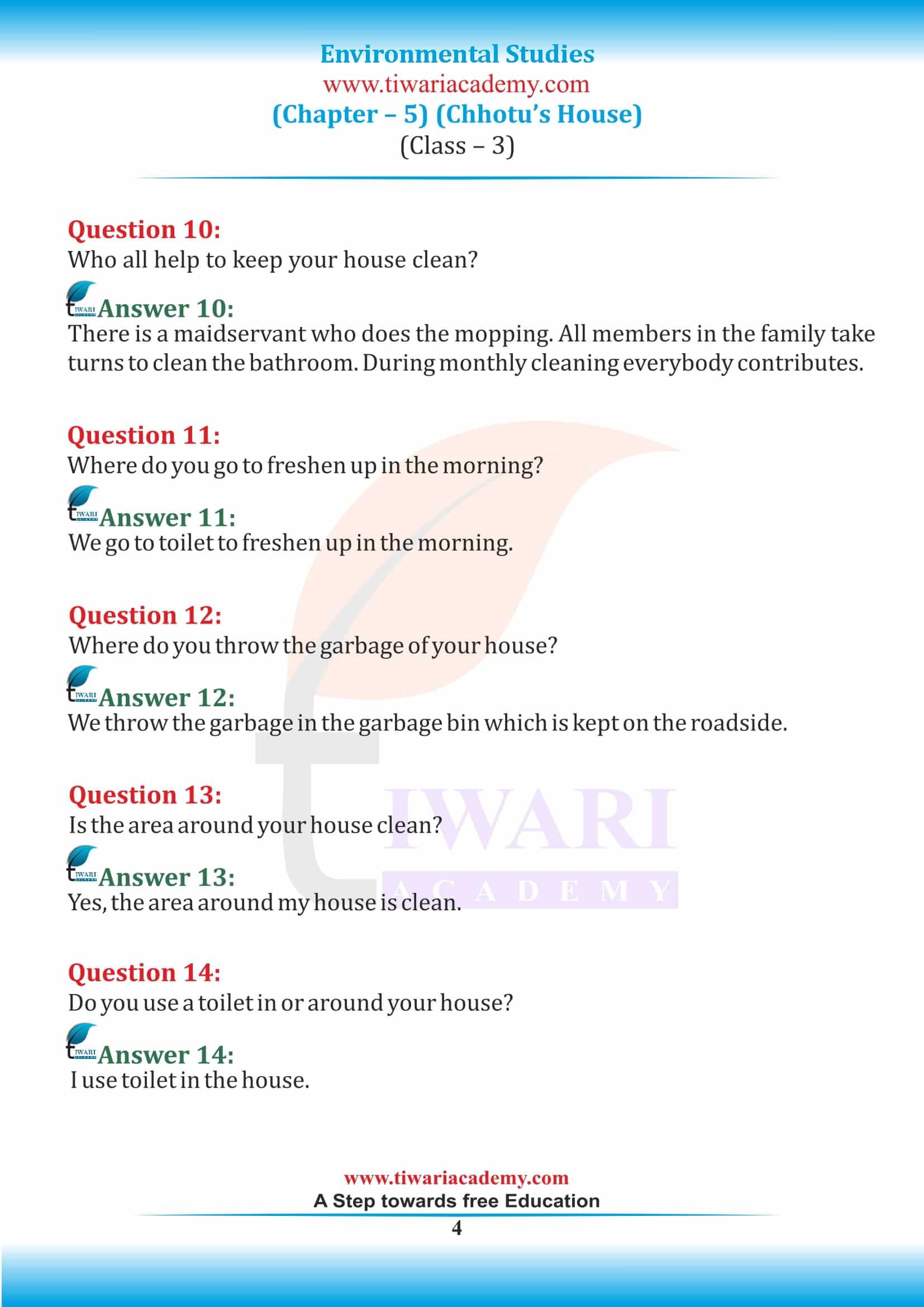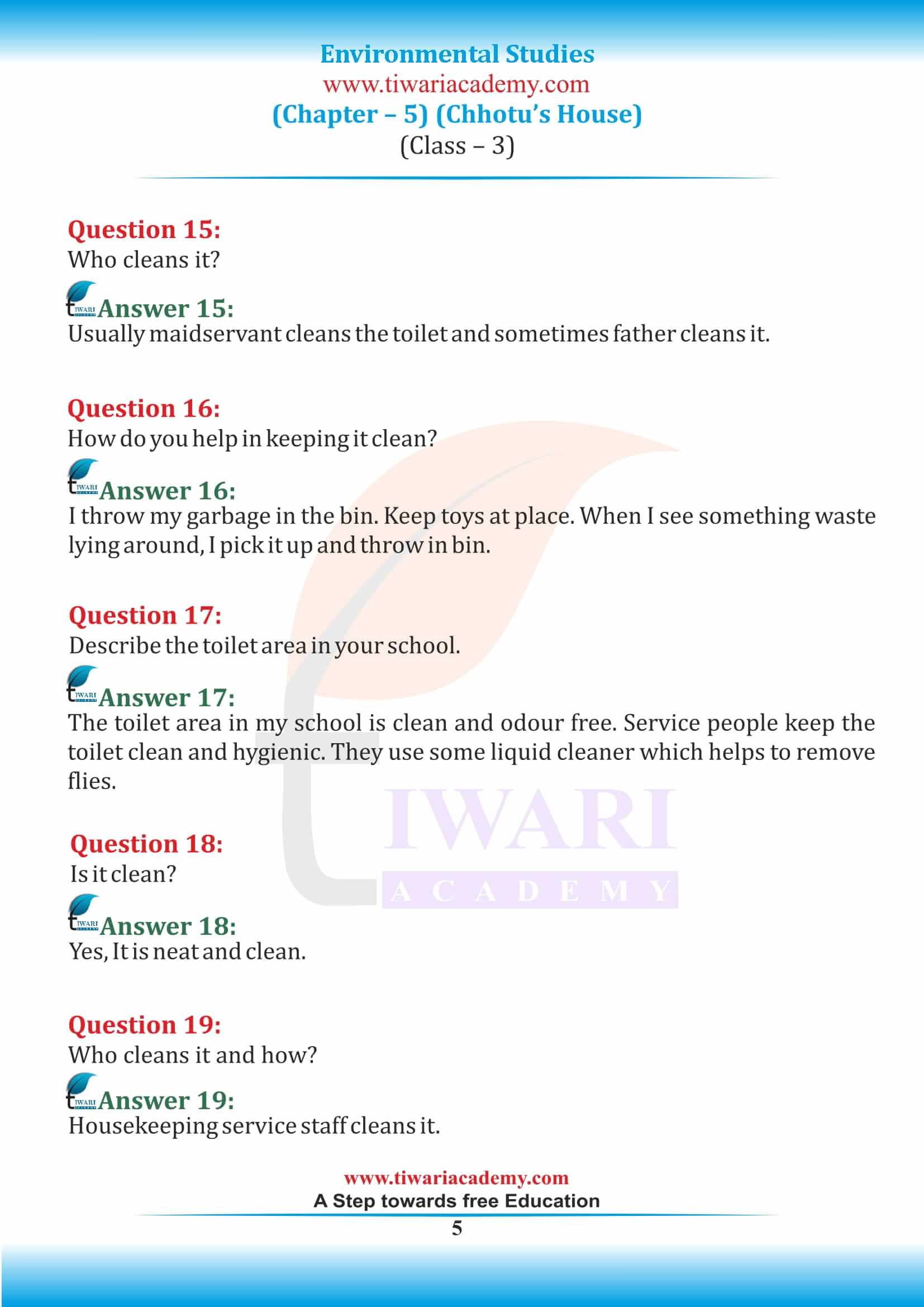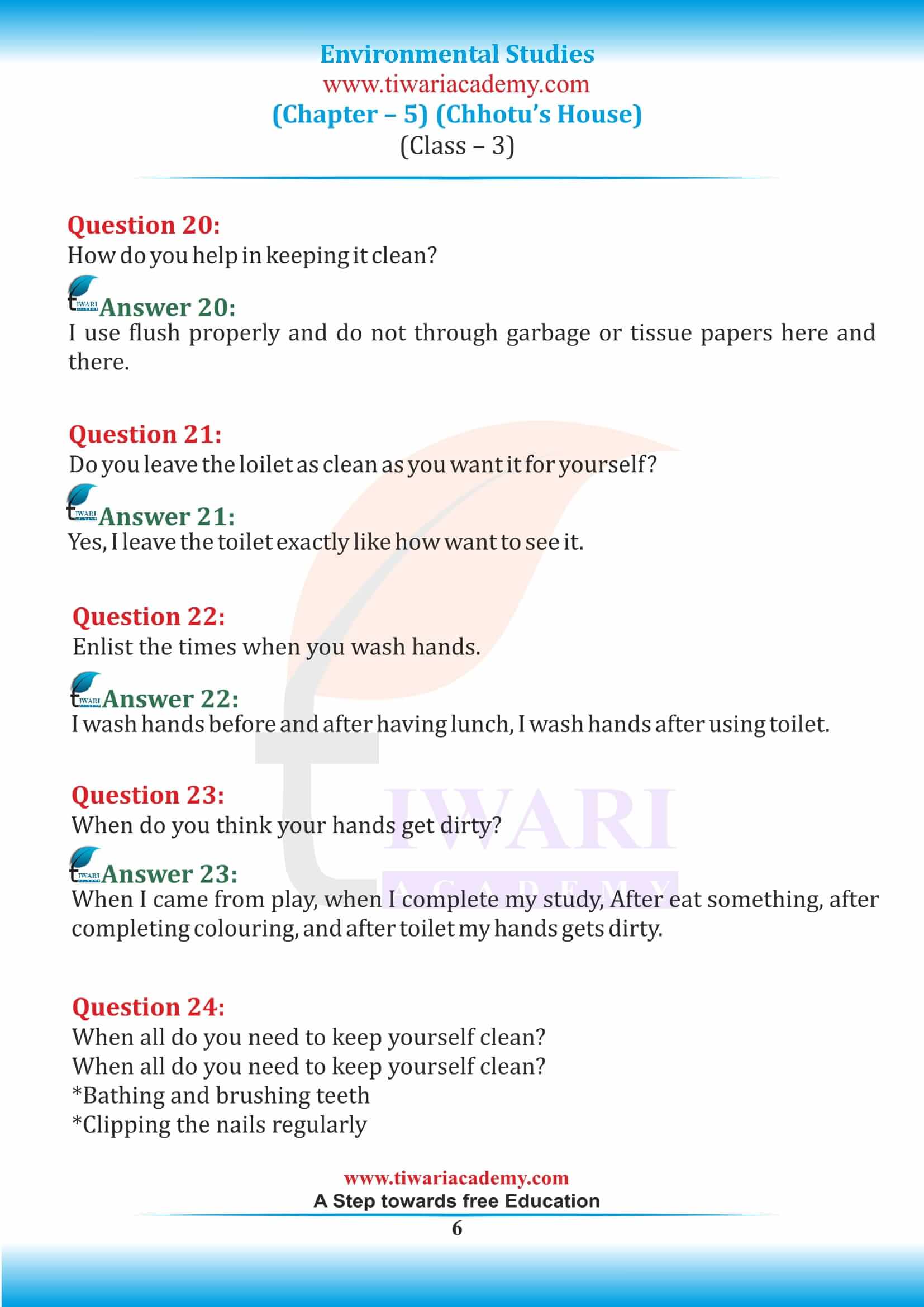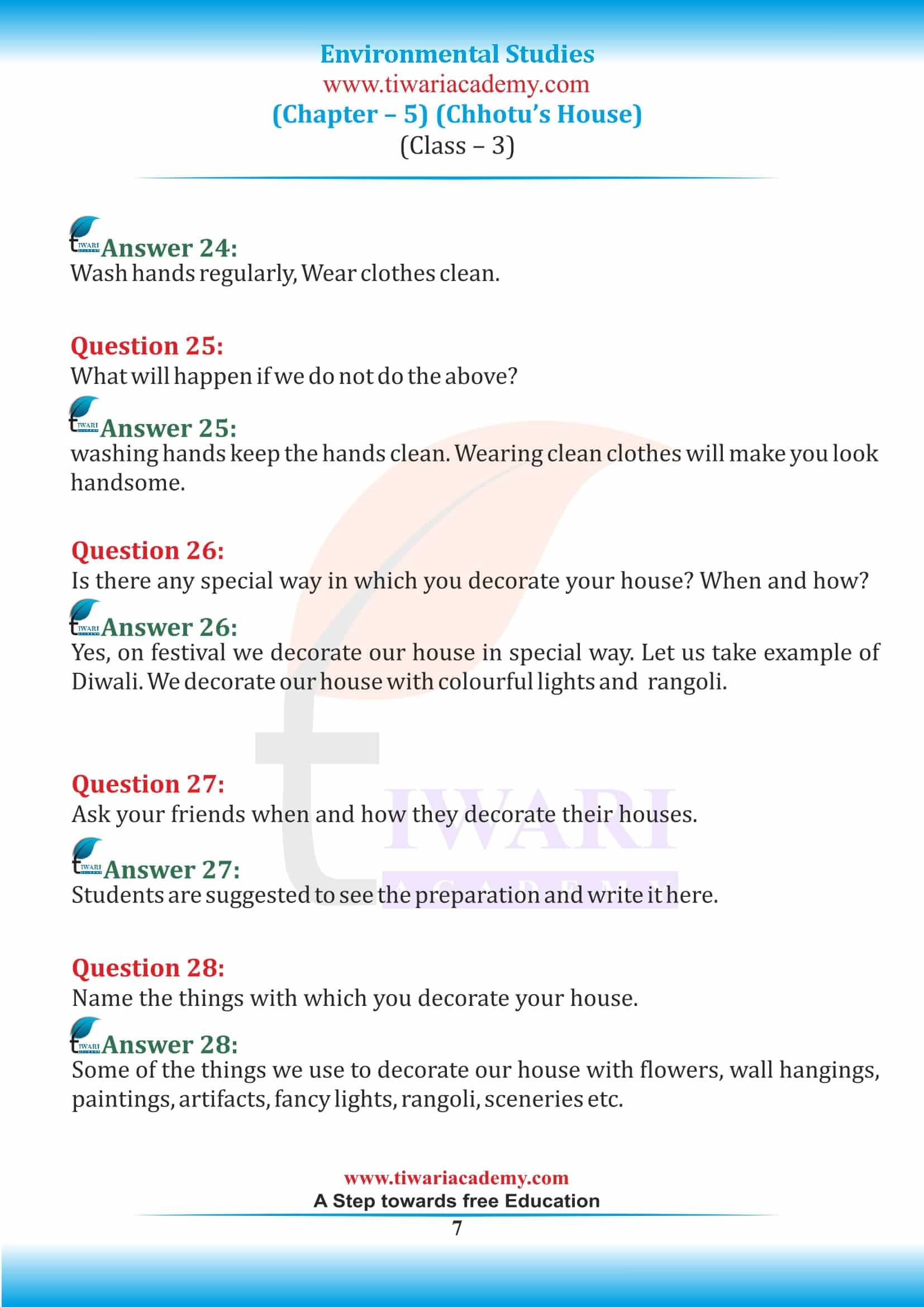NCERT Solutions for Class 3 EVS Chapter 5 Chhotu’s House in English and Hindi Medium Solutions from NCERT Book Environmental Studies Looking Around updated for CBSE 2025-26. Here we will study about the Chhotu’s feeling when he see the outer world from his house. We will learn about his thoughts when he see through pipe. All the question answers are given here easy to understand format. Class 3 EVS Chapter 5 Solutions are free to use without any registration.
NCERT Solutions for Class 3 EVS Chapter 5
NCERT Solutions for Class 3 EVS Chapter 5 Chhotu’s House
Study the pictures carefully and answer the following:
Class 3 EVS Chapter 5 Important Question and Answers
What did Chhotu think when he looked at the pipe?
When Chhotu looked at the pipe, he thought that pipe would be the safest place to live in. Pipe could save him from strong winds, rain and cold weather conditions.
How did Chhotu use the pipe?
Chhotu used the pipe as a home.
Into which parts did Chhotu divide the pipe and its surrounding area?
Chhotu divided the pipe and its surrounding area into following parts:
•A part for sleeping
•A part for cooking
•A part for drying clothes
•A part for storing water
•A part where guests can sit or guest room.
In which part of this house will Chhotu like to spend most of his time?
Chhotu would like to spend most of his time in the part which was meant for guests.
Why do you think Chhotu invited Monu to live with him in the pipe?
Chhotu invited Monu to live with him in the pipe because of following reasons:
•Monu had no place to live
•Chhotu needed someone’s company.
Who all live with you in your house?
My family members, including my father, mother and my sister, live in my house. Chhotu divided the pipe into different parts. Write the names of different parts of your house. My house has following parts:
•Drawing room
•Bedroom
•Toilet
•Bathroom
•Kitchen
•Study room.
How much’ time in a day do you spend in each part of your house?
| Part of house | Time spent in a day |
|---|---|
| Bedroom | 8 Hours |
| Drawing Room | 1 Hours |
| Study Room | 4 Hours |
| Kitchen | 1/2 Hours |
| Bathroom | 1/2 Hours |
Is there any part of your house where one particular member of your family spends more time?
Yes, my mother spends most of her time in the kitchen.
Is there any part of your house where a particular family member never goes or goes for a short time?
Yes, my father never goes to the kitchen or goes for a short time.
How do you keep your house clean?
We clean our house by following methods:
•There is regular cleaning with broomstick.
•There is regular mopping of floors.
•Bathroom is cleaned on a daily basis.
•Once in a month the whole house is cleaned by vacuum cleaner.
Who all help to keep your house clean?
There is a maidservant who does the mopping. All members in the family take turns to clean the bathroom. During monthly cleaning everybody contributes.
Where do you throw the garbage of your house?
We throw the garbage in the garbage bin which is kept on the roadside.
Is the area around your house clean?
Yes, the area around my house is clean.
Is there any special way in which you decorate your house? When and how?
Yes, on festive occasions we decorate our house in special way. Let us take example of Diwali. We decorate our house with colourful lights and with rangoli.
Name the things with which you decorate your house.
Some of the things we use to decorate our house are as follows: flowers, wall hangings, paintings, artifacts, fancy lights, rangoli, sceneries etc.
Class 3 EVS Chapter 5 Extra Questions Set 1
Lata decorated her house with
A clean house is free from _________.
Chhotu needed a house in Mumbai:
What are the different parts of a house?
Class 3 EVS Chapter 5 Extra Questions Set 2
Different materials used for making a house are:
What are the different kinds of houses?
Why should we allow sunlight to enter our house?
The materials used for making a kutcha house is:
We have wire netting in our house to keep:
What facilities should a home have?
A home has the following facilities:
• It should be well ventilated.
• A good home should have a proper drainage system.
• The windows and doors should have wire netting to keep away flies and mosquitoes.
• A good house should allow sunlight and fresh air to come in.
• It should be built with all the facilities to make the people living in it comfortable
What are pests?
They also include those animals which carry diseases, microorganisms and parasites.
Mosquitoes, fleas, bugs, black ants, lizard, flies, mosquitoes, spiders, rats, cockroach etc. are some examples of pests. They are uninvited and unwanted guests like rats, insects, etc. which may cause illness or damage or consume food crops and other materials important to humans. They hide themselves during the day and come out of their hiding places in search of food at night.
Explain the different types of houses.
Different types of houses are-
1. Stilt house: In places having heavy rainfall houses are made on wooden posts high above the ground. These houses are called as stilt houses.
2. Sloping rooftop houses: In places that receive heavy snowfall people build sloping rooftop houses. This type of rooftop lets the snow slide down easily.
3. Tent: Tents are used as temporary by campers, soldiers and scouts. They are made of canvas. They can be carried anywhere.
4. Boathouse: A boathouse is a boat with a house.
5. Multi-story building: Tall buildings are built in big cities and towns which have many floors. Each floor has many houses. Each house is called as a flat.
What should we do to keep pests away from our house?
To keep the pests away we should do the following things:
1. Keep the kitchen clean as the pests increase in dirty, damp atmosphere.
2. Keep the bathroom clean.
3. Do not allow water to stand as mosquitoes breed in standing water.
4. Don’t keep fruits and vegetables out for long.
5. Dispose of garbage regularly as it attracts germs and flies
6. Maintain your garden.
7. Keep items of external use outside.
8. Fix nets on windows to stop the entry of flies and insects.
How can we keep our houses clean?
Apart from being strong, a house should also be clean. It is very important for our health that we keep our houses neat and clean. To keep the house clean we should:
i. Sweep and dust our house daily.
ii. Keep things in their proper places.
iii. Throw all the garbage outside the house into the covered dustbins.
iv. Do not spill food or water on the floor. If it happens by accident, clean it immediately.
v. Make sure that our kitchen and bathroom floors always slope towards the drain. This will allow the water to flow away easily and keep the floor dry.
vi. Not let any garbage or water collect outside the house, as this attracts germs and mosquitoes that cause diseases
Class 3 EVS Chapter 5 Important Question and Answers
What would happen if we do not dispose of garbage properly?
If we do not dispose of the garbage properly and throw it in an open area, it spreads diseases as flies and mosquitoes tend to sit on it which contaminate our food. Also, they cause malaria, jaundice etc. that severely affect human health. So, proper waste disposal is important for the environment. If garbage is not removed regularly from our homes and surroundings, then they will become dirty. Some of the garbage will rot giving off foul smell. The rotting garbage will become a breeding ground for disease causing organisms such as cockroaches, flies and mosquitoes. Removal of wastes from public areas reduces the risks to overall health, reduces the growth of pests, and decreases various health hazards.
Why should our houses have proper drainage system?
Our houses must have a good drainage system to carry away the dirty water. Dirty water is the breeding house for mosquitoes and germs. A good drainage system allows the free flow of water and in most cases prevents gathering of water that can lead to flooding. Drainage systems also prevent the building up of stagnant water, which can encourage mosquitoes to breed.
Why should we throw garbage in separate dustbins?
We should throw garbage in separate dustbins as it is important for the environment and it is processed in the right way if put in separate bins. The separation of waste ensures that recyclable materials are reused when making new products. This is also called recycling. Harmful waste requires special handling as it can cause serious problems. By putting them in separate bins we can reuse and recycle the non-harmful waste.
What are the factors on which the type of house depends?
The following factors should be considered for the type of house to be made:
• Purpose of Building.
• Friendly Neighbourhood.
• Available Facilities. Like food, fruit, vegetables and other groceries.
• Shape & Size.
• Natural Light & Air.
• School and hospitals
Why do animals live in houses?
Animals need shelter to protect them from intense nature, harsh weather and also to save them from their predators. The animals need to save their lives from these natural calamities and hence they need a protective shelter. Animal homes are as varied as the animals living in them. The environment in which an animal lives (its habitat) must provide water, food, shelter, and space.
How should the garbage be disposed?
Improper disposal of garbage is a major problem. Keeping the surroundings clean and disease free is everyone’s responsibility. Some people litter the streets and roads and do not throw garbage in a dustbin. This causes land pollution and spread of infections.
If we throw garbage in a dustbin, the sweepers collect it from our homes and dump it in the closed garbage bins. The municipality trucks carry this garbage away from the city for disposal..We can dispose waste in the following ways-
(i) Separate into biodegradable and non-biodegradable, recyclable and non-recyclable wastes.
(ii) Recyclable wastes (waste paper, cloth, polythene or plastic bags, cartons, bottles, cans, etc.) can be given to rag pickers for recycling.
(iii) Preparation of compost from kitchen wastes for home garden (kitchen garden).
(iv) In the absence of kitchen garden, the household garbage and other wastes can be given to waste collectors for disposal.
Where in our house do we usually find birds?
We can find them on our balconies. They must have come there to take some rest. We can also, provide some grains and water for them. The birds come there where they can find some food for themselves. Birds like pigeons and sparrows like to stay close to human beings so they make their nests in our homes, on windows, AC units, fan tops etc.
Class 3 EVS Chapter 5 Important Question and Answers
What are waste produced at home?
Most of the waste generated at home consists of food leftovers like fruit peels, vegetables, spoiled products, newspapers and magazines, bottles, packaging in general, toilet paper, disposable diapers and a wide variety of other items, including products which may be toxic. Milk pouches, polythene bags, empty cartons, Waste paper (newspaper, bags, envelopes), packing paper, empty bottles, tom cloth pieces, etc. Dust and other sweepings are also waste produced at home.
What is a house? How is it different from a home?
Houses are made of wood, bricks, cement, steel and glass. Roof and walls are made of steel, bricks and cement. Our house protects us from the Sun, rain, wind, snow, animals and enemies. Different types of houses are bungalows, flats, cottage, hut, igloo, houseboat, mansion, etc.
A house becomes a home when the loving members of a family live together in it, care for each other, support and help each other and share their joys and sorrows together.
What are the features of a good house?
The features of a good house are as follows:
• Our houses must have a good drainage system to carry away the dirty water. Dirty water is the breeding house for mosquitoes and germs.
• Our houses must have open spaces in front or back of our house and balconies also to get enough sunlight and clean air.
• They should have sufficient doors and windows
• Should have different or separate places for different purposes like cooking, eating sleeping, bathing, resting, studying and storage.
• The sanitary system in the house should be good.
• There should be proper water supply and storage system for continuous availability of good water
What is a shelter?
A shelter is a place that protects and provides safety for any living organism which live there. All living things need shelter as it gives them a security and protects them from the harsh weather conditions, thieves and other things.
How are pucca houses better than kutcha houses?
Houses that are made of bricks, cement, and steel are strong and are called pucca houses. Most people live in huts which are made up of mud, straw, bamboo and palm or coconut leaves. They are called Kutcha houses. Pucca houses are strong than the Kutcha houses as it is made up of bricks and cement. The pucca house is a complete and permanent house. It cannot be destroyed by to winds, floods and other things. Any house, where the walls are made up of bamboo, mud, grass, reed, stones, thatch, straw, leaves and unburnt bricks, are known as kutcha houses. These are not permanent structures like flats or buildings. Kutcha houses are usually seen in rural areas or in cities where workers choose to make make-shift homes.
Differentiate between kutcha house and pucca house:
| Kutcha House | Pucca House |
|---|---|
| 1. Made of easily available raw materials, like mud, straw, stones or wood. | Built with iron, bricks, cement, steel, etc., to form a concrete structure. |
| 2. An unstable structure with a risk of being damaged by natural disasters. | Stable and concrete buildings cannot be broken into easily. |
| 3. Rooms may or may not be separately divided. | Rooms are separate as bedrooms, hallways, living rooms, kitchens and bathroom etc. |
The chapter is teaching us something about welfare in a city through the story of Chhotu. The chapter is entirely based upon the importance of home.
How do you think chapter 5 of class 3 EVS represents creativity?
At the beginning of the chapter, you will see the story of the character named Chhotu explained in form of pictures. They could’ve completed the story by telling the story in simple language instead of book letting students complete the story by looking into the pictures.
How do you suggest one can prepare chapter 5 from 3rd class EVS for examination?
The main part of chapter 5 from class 3 EVS is the story of Chhotu and to complete the story one should read and understand the feeling that has been expressed along with the welfare quality in Mumbai.
